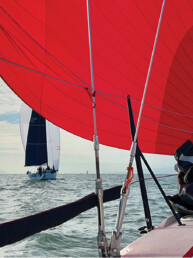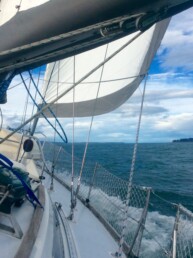Now is the time to join or support a local high school sailing program in the PNW
This article was originally published in the February 2022 issue of 48° North
As the spring season for high school sailing rapidly approaches, coaches all over the Pacific Northwest are stepping up their recruiting efforts — I know, because I’m one of those coaches. If you have a high schooler in your life who you think would enjoy the sport of sailing, here’s a breakdown of some of the most frequently asked questions we get, and the reasons your high schooler should sail.
What type of boats do we use?
High school sailing primarily uses two-person 14-foot Flying Junior dinghies (better known as FJs). The boats are sailed with one person at the tiller and controlling the main (skippering) and one person controlling the jib (crewing). This configuration is doublehanded sailing. While this is common, there are other high school and youth sailing events that use single-person Lasers, as well as occasional keelboat events. This year, high schoolers will use the J/70 for keelboat nationals qualification.
Is it Co-Ed?
Yes! High school sailing is co-ed. There are a few women’s-only regattas and clinics but all regular competitive events are co-ed. Being part of a co-ed sport gives young people better problem-solving and interpersonal skills. While fitness will certainly make for a better sailor, sailing is a sport that balances the physical with the intellectual, and size differences among people tend to balance out. As a co-ed sport, all kids — regardless of gender identity and expression — are welcome.
Are there college scholarships for sailing?
This is my favorite and least favorite question about youth sailing. The short answer is no. To maximize fairness and to put academics first, the national entity that oversees youth sailing, the Interscholastic Sailing Association (ISSA), does not allow schools to
offer sailing scholarships.
That being said, I can’t think of a better sport when it comes to applying for schools and scholarships. The likelihood of going to college on a full-ride sports scholarship isn’t a reality for most people, regardless of their chosen sport; but participating in something as unique as sailing is an excellent way to gain the type of experiences that college application and scholarship essays want to hear about. Working as a team in challenging conditions that are always changing, while having great adventures with your friends, is the type of thing that will make sailors stand out. Most schools have soccer, softball, and chess teams to offer, but sailing is something distinctive.
Once sailors are in college, sailing teams offer a great way to have a community of people with a shared passion from which students can find support. And just because there aren’t college scholarships on offer, doesn’t mean there aren’t special opportunities that present themselves for keen and progressing scholastic sailors. Active sailors may find they have chances to sail with some of the top racers in the region (and beyond), or to travel to exciting locations to go sailing. With so many boats and types of racing being done by all ages and experience levels, there really is something for everyone.
Do I need to have any sailing experience?
No. Each team varies in composition, with some kids having sailing experience and others being new to the sport, but walk-ons (new sailors) are always welcome. Plenty of highly accomplished sailors got their start with their high school sailing team. There’s no easier time for new sailors to learn how to sail than through high school sailing. It’s more affordable than private lessons or buying your own boat, and helps you get established in the sailing community.
Is sailing a WIAA sport?
No, most sailing programs in the Pacific Northwest are run through a local community boating center or yacht club, not the Washington Interscholastic Activities Association (WIAA). The level of connection to the team’s school varies from team to team — with a few being regular school sports and others being entirely independent. This has its advantages and disadvantages, but the basic requirements for participation are similar to most school sports. One of the advantages is that you may be able to find a local team to race with, even if your high school doesn’t offer a sailing team.
The organizing body for high school sailing in the Northwest is called the Northwest Interscholastic Sailing Association (NWISA). This is the Northwest region’s ISSA chapter, ISSA is the national body for high school and college sailing. ISSA sets the rules and hosts national events.
Isn’t sailing really expensive?
Sometimes, but it doesn’t have to be. Most youth sailing schools will tell you that their primary goal is to get as many kids out on the water and enjoying the sport as possible. They make sailing accessible by providing equipment and some programs even provide the gear kids need (a wetsuit, bibs, sail booties, a lifejacket). Compared to other sports and activities, high school sailing costs about the same, and local scholarships and sponsorships are available at the high school level at most programs to make the sport less cost-prohibitive. Coaches work hard to raise funds to get kids out on the water.
When is the season and where do we go?
The first regattas of the year typically start in early March and run through mid-June, but practices often start in mid-to late February. It’s not uncommon for there to be snow on the ground when the season starts, and to be able to sail in shorts and a t-shirt when the season is wrapping up.
One of the best parts of the NWISA sailing season is the variety of places kids get to sail. This year the local list of venues includes Bellingham, Sail Sand Point (Magnuson Park), Oak Harbor, and others. For nationwide invitationals, sailors this year have gone to New Orleans, San Diego, Los Angeles, and Chicago.
How do I get involved?
Check the NWISA website to see if your school has a team, or what teams are close by and what sailing center they use. Team contact info can be found there. Reach out and coaches will be happy to tell you more specifics on how to join a team.
If you’re not a high schooler and don’t have one in your life, there are plenty of ways to get involved and support high school sailing. Most events and programs rely heavily on volunteers. Whatever your skillset is (web design, carpentry, photography, fundraising, landscaping, cooking) we can find a way to put you to work. Help is needed at the individual program level as well as with NWISA events as a whole. Each regatta needs volunteers on and off the water. If you don’t have the time to volunteer, donations to your local team, NWISA, or the Northwest Sailing Foundation are always welcome.
Julia Soes
Julia Soes is the head coach and program director of Sail Orcas and a member of the NWISA board. She races PHRF through the Anacortes and Orcas Island Yacht Clubs and is restoring the fastest Cal 20 the world has ever known, which only rates 300.






